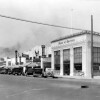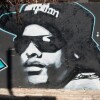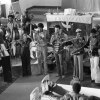Before Motown: L.A.'s Black-Owned Soul Music Empire

During the 1950s and 1960s, Los Angeles had its own Motown records. Dootone Records began on a front porch in Watts and grew to become one of the largest Black-owned record labels in the country. The label's owner, Dootsie Williams, was a trailblazing Black music executive and entrepreneur who not only left an impact on the music industry, but also in his community.
Born in Alabama in 1911, Williams moved to Los Angeles with his family when he was four years old. Growing up in Watts, he played the trumpet and violin and attended Jordon High School and L.A. City College. After a stint in the Army, Williams returned to Los Angeles and began pursuing a career in music. While he achieved success as a bandleader and songwriter, he found that his true calling was on the business side of the entertainment business.
Two factors pushed him to start his own record label. First, Williams noticed that the musicians he was working with were not making that much money and were always being told what to do by their managers. Williams wanted to be his own boss. Years later, he told a class at UCLA: "[T]he desire to be in business, to be independent, to be my own boss — was the first step, the first key factor, in [my] success story." Second, he was getting sick of watching white-owned companies exploit Black artists. He said:
For years I watched record firms steal the arrangements and music of Negro artists and musicians and reproduce it in a manner which was not fitting to the music. Although the firms exploited the music they did not give proper credit to the people from which they had taken it.
So, Williams formed his own record label called Blue Records in 1949. In 1951, he changed the name to Dootone Records. A few years later, in 1957, he changed the name again to Dooto records to differentiate his company from another similar sounding company and to avoid a lawsuit. In the beginning, Williams ran the record label out of an enclosed front porch at his parent's house in Watts. Later, the family moved out and the record label took over the entire house.
After releasing a handful of blues, jazz, and party song records, Dootone Records scored a massive hit in 1954 with the doo wop song "Earth Angel." The song was recorded in a backyard garage studio by a vocal group called the Penguins, which was composed of four high school students from South Los Angeles. After climbing the R&B charts, the song crossed over and reached number eight on the pop charts, despite the fact that two popular cover versions of the songs were released at the same time by white acts. At the time, it was common for white artists to cover Black artists' songs and the "white covers," rather than the originals, would go on to achieve success on the pop charts. There was a notion in the entertainment business that white kids would not purchase music by Black artists or that the music had to be made more "palatable" to a white audience. And here, the "white cover" of "Earth Angel," by the Crew Cuts, hit number three on the pop charts. What was different this time was that the Penguin's version also made it to the top 10 on the pop charts. "Earth Angel" was one of the first crossover teen hits by a Black group. As such, it changed the course of popular music and paved the way for later groups, such as the Platters. Notably, the song was recorded in the same year that the U.S. Supreme Court declared in Brown v. Board of Education that separate schools for Black and white children were inherently unequal.

The success of "Earth Angel" made Dootsie a fortune and garnered his record label national attention. Dootone Records grew to become one of the largest Black-owned record labels in the nation. The Chicago Defender called it "the largest Negro-owned record label long before Motown ever dreamed of such an empire." Dootone, and later Dooto Records, would go on to release a wide variety of doo-wop, rhythm and blues, gospel, blues, jazz, and comedy records. Dootsie took pride in promoting different forms of black expression. He later explained:
There is a wealth of talent among Negroes. This talent, this gift, this ability is, in my opinion, unsurpassed. But not always has this talent of the Negro been given an opportunity to express itself to capitalize on its value in the open market of American competition. We have striven to remedy this situation.
Listen to some songs from Dooto Records:
Williams also gained a reputation for finding previously undiscovered talent. He discovered the singer, Vernon Green, when the 16-year-old high school student was walking down the street singing out loud. Williams discovered the singer, Willie Headen, when Headen was singing out loud while shining Williams' shoes. Another Williams discovery was the singer and comedian Rudy Ray Moore, who would later write and star in the iconic Blaxploitation film "Dolemite." But, Dootsie's biggest discovery was a comedian named John Elroy Sanford, better known as Redd Foxx. After seeing Foxx perform, Williams approached the comedian about recording his act. Foxx was initially hesitant, fearing that people would not pay to see him perform live if they could listen to his act on a record. Foxx eventually agreed and Williams released Foxx's "Laff of the Party" in 1956. It was a huge success and reportedly sold a million copies in just a year and a half. Buoyed by the success, Williams went on to release over a dozen Foxx records. According to comedy historian Kliph Nesteroff: "Dootsie William and Redd Foxx invented comedy records as we know it — but like so many groundbreaking Black talents of the recording industry, they never got the credit."
It is unlikely that any Negro-owned center of this kind is to be found anywhere else in America.Los Angeles Sentinel
In addition to his own personal success, Williams was committed to the advancement of the Black community. He was involved with multiple social service groups and started the Negro Business and Professional Club in Compton. Williams also supported up and coming Black politicians, such as Douglass Ferrell, who was the first Black man elected to the California Assembly from the 55th Assembly District, and Douglas Dollarhide, who became the first Black mayor of Compton. According to Dollarhide: "Dootsie did a lot for the city as well as himself. He was so charitable that I had to tell him: 'There is a limit to everything.' He really was an asset to the community. He helped to get Compton rolling when Blacks were taking over."
But, Williams' biggest contribution to the community was the Dooto Music Center. Bothered by the lack of Black-owned event spaces in Los Angeles, Williams built his own. Opened in 1962, the Dooto Music Center offered top-notch facilities for concerts, dances, banquets, club affairs, political campaign rallies and conventions. It became the scene for many important social and political events, and served the day-to-day needs of the community as well. A typical Saturday at the Dooto Music Center could include dance classes for kids during the day and an event for the Compton Chapter of the NAACP at night. In addition, famed artists such as Bobby Blue Bland, the Miracles and B.B. King appeared regularly at the venue. In 1963, the Los Angeles Sentinel described the Dooto Music Center as "the most-needed cultural and recreation center in Southern California."
The location Williams chose for his center, at Central and 135th Street in Compton, was deliberate. Williams built it next door to a bowling alley called the Sportsman Bowl, which was owned by another black entrepreneur named Woodley Lewis. In 1962, Lewis, a Compton native who had been one of the first players to break the color barrier in the NFL, bought the bowling alley with an attached restaurant and lounge. Together, Williams and Lewis marked a new wave of Black entrepreneurship in Compton. In 1963, the Los Angeles Sentinel wrote: "It is unlikely that any Negro-owned center of this kind is to be found anywhere else in America."

But not everyone in Compton was pleased with the Dooto Music Center. At the time, Compton was in a state of upheaval as a growing Black population struggled to find its place in the previously all-white city. For decades, Compton's status as a white city was enforced by restrictive covenants. In fact, in 1944, the U.S. Census counted only six nonwhite residents of Compton. But, in 1948, the Supreme Court ruled that restrictive covenants could not be enforced. As a result, during the 1950s, a small, but growing Black community developed at Compton's northern border. The growing presence of Black families at Compton's northern border resulted in fear and hostility from many in Compton's white community. Meanwhile, white flight, which was spurred on by unscrupulous real estate practices like blockbusting, rapidly transformed the racial makeup of the city.
By 1960, Compton was around 40% Black and many whites in Compton were not happy about their new neighbors. To them, the Dooto Music Center was a manifestation of this change and a threat to the pre-existing racial hierarchy in the city. Consequently, several so-called concerned residents started lodging complaints about the Center with the city and asked that special regulations be placed on the venue to limit or prevent events from occurring there. The proposed restrictions, which became known as "The Dootsie Williams Ordinance," were rejected by the Compton City Council in 1963 after Williams and the Compton Chapter of the NAACP called the effort out as being discriminatory.
I have always operated on the theory that the Negro race abounds in theatrical talent. One of my constant goals is to bring this talent into profitable fruition.Dootsie Williams
Next, seeing the lack of diversity in film and television, Williams formed a film production company in 1959. In addition to film, Williams planned to start a television station to serve the Black community, based out of the Dooto Music Center. Like the music industry, Williams believed there was a tremendous amount of untapped acting talent in the Black community. He said: "I have always operated on the theory that the Negro race abounds in theatrical talent. One of my constant goals is to bring this talent into profitable fruition." And when the trailblazing Black filmmaker, Horace Jackson, needed help getting his movies off the ground, Williams provided him with financial support and office space.
While Williams had high hopes for film and television, he could not develop it into a successful part of his company. At the same time, the success of the record label started to wane as Williams grew tired of the increasing use of payola in the record business. As a result, Williams turned his attention away from film, television and producing new records, instead focusing on music publishing and the Dooto Music Center.
Williams continued to run the operations at Dooto Music Center until his death in 1991. After his death, all of Williams' businesses were dissolved and he willed half of his estate to the United Negro College Fund. His grandson ran the Dooto Music Center for a few years before it too was sold and demolished. And just like that, Dootsie Williams vanished. According to a longtime friend: "this great Black man has been removed from this earth without a trace."
While the man may have been forgotten, his legacy endures. The songs he produced continue to be played on radios throughout the world. The song "Earth Angel" will forever hold a place in the great American songbook and, as one of the first crossover hits, it changed the course of popular music. It cannot be overstated that in 1955, a Black musical group on a Black-owned record label climbing the pop charts was groundbreaking.
With his record label, Williams provided a forum to showcase Black talent in Los Angeles and helped launch the careers of multiple artists. While there were many successful Black musicians and performers at the time, the promoters, managers and executives behind the scenes were almost exclusively white. Williams was part of an emerging group of Black entrepreneurs who started taking positions of power in the entertainment business and in the process, disrupted the existing racial hierarchy. And when he saw the lack of diversity in film and television, he tackled the problem himself, by trying to build a Black-owned media empire based in Compton. Years later, Williams commented: "[i]f we wait for whites to promote the black issue, the black concept, the black viewpoint, we'll be waiting a long time." Whether it was music, film, business, or politics, Dootsie Williams wanted to reframe the narrative of Black Los Angeles with Black people themselves as the protagonists.

Sources
Johnson, Robert Lee. Notable Southern Californians in Black History. Charleston: The History Press, 2017.
Nesteroff, Kliph. The Comedians: Drunks, Thieves, Scoundrels and the History of American Comedy. New York: Grove Press, 2015.
Otis, Johnny. Upside Your Head! Rhythm and Blues on Central Avenue. Middletown: Wesleyan University Press, 1993.
Starr, Michel Seth. Black and Blue: The Redd Foxx Story. Milwaukee: Applause Theater and Cinema Books, 2011.
Ward, Brian. Just My Soul Responding: Rhythm and Blues, Black Consciousness, and Race Relations. Berkeley, University of California Press, 1998.
Moore, Rudy. Below the Belt. Dooto Records DTL 808, 1960, record, liner notes.
Dawson, Jim. The Dootone Story: Volume 1, Ace Records, CHD 242, 1988, record, liner Notes.
"Dootsie Williams Forms Movie Firm." Los Angeles Sentinel, May 21, 1959.
Young, A.S. "He Builds Empire on Music, Humor." Los Angeles Sentinel, June 25, 1959.
Young, A.S. "Dooto Records Celebrates It's 15th Anniversary." Los Angeles Sentinel, July 6, 1961.
"Plan $100,000 Site For Dooto Records." Los Angeles Sentinel, February 15, 1962.
"UCLA Music Class Hears Dooto Prexy." Los Angeles Sentinel, May 10, 1962.
"Dooto Firm Plans Radio, TV Outlets." Los Angeles Sentinel, August 9, 1962.
"Dooto Center Offers Dancing Class for Teens." Los Angeles Sentinel, January 17, 1963.
"'Dootsie Williams' Ordinance' Flops At Compton Hearing." Los Angeles Sentinel, April 4, 1963.
"Dootsie: Ideal Watt's Entreprenuer." Los Angeles Sentinel, March 6, 1969.
Young, A.S. "Final Journey for Three Prominent Citizens: Dootsie Williams." Los Angeles Sentinel, August 29, 1991.
Young, A.S. "Nobody Asked Me, But." Los Angeles Sentinel, September 5, 1991.
Young, A.S. "Thinking About Dootsie Williams." Los Angeles Sentinel, December 9, 1993.
Jim Dawson, in discussion with the author, April 2021.
Duane Filer, in discussion with the author, April 2021.
Walter Williams, in discussion with the author, April 2021.








